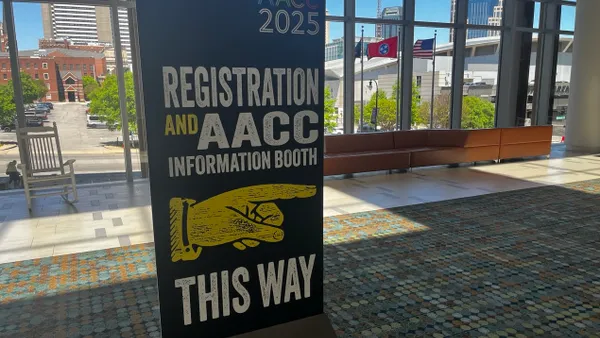Dive Brief:
- A student who is a parent and works 10 hours per week at a minimum wage job cannot afford the cost of both college tuition and child care at a public institution in any state, according to a new report from the Education Trust, a nonprofit organization aiming to improve college access and equity.
- Student parents need to work more than 50 hours per week to afford tuition and child care with a minimum wage job, on average across the country. The state of Washington, due to relatively low tuition and high minimum wage, offers better access for student parents than other states, the report said — but a parent still needs to work 30-33 hours per week to cover tuition and child care. Pennsylvania and Georgia offer some of the worst conditions for student parents, with parents who use child care centers needing to work 81 and 77 hours per week, respectively, to cover those costs.
- Authors recommended increasing the federal minimum wage, doubling the Pell Grant for low-income students, expanding on-campus child care and collecting data about student parents.
Dive Insight:
Supporting student parents could help institutions with enrollment woes and, by extension, state economies. But higher ed systems need to seriously improve to serve this population, the report authors said.
The researchers looked at the average cost of tuition for low-income students at public universities after grants were applied. They then added child care costs minus the value of 10 hours of minimum wage work to determine a student parent “affordability gap.” They chose 10 hours because it is "a reasonable workload that won't jeopardize academic success," according to the report.
High child care costs often made college unaffordable for student parents. In Washington, D.C., for example, net tuition for low-income students is about $15,000. But student parents are likely to still have a gap of more than $30,000 after paying for child care and subtracting wages.
Some states, like Florida, have made gains in curbing the cost of child care, said Jinann Bitar, director of higher education research and data analytics at Education Trust.
But the effects of those gains may be dampened by low state minimum wages or high tuition. Students in Florida have the lowest affordability gaps of students in any state, but they still need to work nearly 40 hours per week to meet those gaps, due to a low minimum wage.
“They land in the middle even though they’ve done work to make child care affordable,” said Bitar, who is also one of the report’s authors. “A state’s reduced child care by a couple hundred dollars or a thousand dollars — or if they reduced tuition by a couple hundred dollars or a thousand dollars — simply did not have the same effect as the amount of wages they would earn if the minimum wage was increased.”
Authors recommended raising the federal minimum wage to $20 per hour to address that issue. They also recommended efforts that would expand on-campus child care, which is typically subject to long waits. They suggested increasing funding for the federal Child Care Access Means Parents in School Program, which supports campus-based child care centers.
Bitar said institutions should prioritize the children of student parents for slots in child care programs, and prioritize parents themselves when students schedule classes. But many of the recommendations would also help faculty and staff who have children, she said.
If institutions had accessible and high-quality child care available for everyone, then institutions wouldn’t need to make those tough decisions around who to prioritize, Bitar said.
“The institution is there with the purpose of serving the student,” she said.












